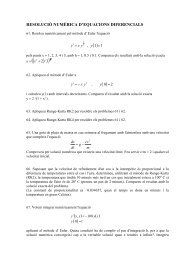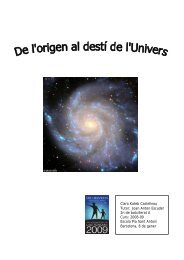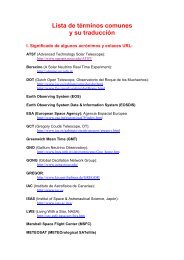Universitat de - Departament d'Astronomia i Meteorologia ...
Universitat de - Departament d'Astronomia i Meteorologia ...
Universitat de - Departament d'Astronomia i Meteorologia ...
Create successful ePaper yourself
Turn your PDF publications into a flip-book with our unique Google optimized e-Paper software.
86 Chapter 2. Multiwavelength approach to LS 5039<br />
2.9 Conclusions<br />
1. Most of the known microquasars have been discovered only after un<strong>de</strong>rgoing<br />
a noticeable outburst, that has triggered the <strong>de</strong>tection by a battery of satel-<br />
lites and ground-based observatories. In contrast, we have discovered a new<br />
microquasar, namely LS 5039, after careful examination of mo<strong>de</strong>rn archive<br />
databases and follow-up interferometric radio observations with different res-<br />
olution (with the VLA, VLBA, EVN and MERLIN).<br />
2. We have found that LS 5039 displays persistent radio emission in the form of<br />
relativistic jets, with a high brightness temperature of ∼ 10 8 K and an optically<br />
thin spectral in<strong>de</strong>x of α −0.5. These results are indicative of non-thermal<br />
synchrotron radiation mechanism.<br />
3. We have obtained the following jet parameters: β 0.15, θ 80 ◦ , a size up to<br />
∼ 1000 AU with a position angle of 125–150 ◦ and a half opening angle smaller<br />
than 6 ◦ . The asymmetry in flux <strong>de</strong>nsity and distance to the core between<br />
the approaching and receding jet seems to be persistent along time. Small<br />
differences in the position angle of the jets, observed at different epochs and<br />
with different resolutions, suggest bending and/or precession of the jets.<br />
4. The radio emission is mo<strong>de</strong>rately variable but no signatures of variability cor-<br />
related with the orbital period, expected because of the LS 5039 eccentric<br />
orbit, have been found. This is probably because of the lack of sensitivity of<br />
the long-term radio observations available up to now (GBI).<br />
5. We have shown that LS 5039 displays slight variability at optical wavelengths,<br />
and mo<strong>de</strong>rate variability at near infrared wavelengths. Based on the new<br />
spectral type classification, O6.5V((f)), and recent calibrations of early type<br />
stars, we have estimated a distance of 2.9 ± 0.3 kpc to LS 5039.<br />
6. We have presented new radial velocity measurements (obtained with the INT)<br />
that confirm the 4.1 d orbital period of this binary system.<br />
7. We have analyzed six and a half years of X-ray monitoring (ASM/RXTE) of<br />
LS 5039, and found no evi<strong>de</strong>nces of periodic variability. In particular, we have<br />
not found the orbital period of the system, expected because of variable accre-<br />
tion rate along an eccentric orbit, probably because the source is marginally<br />
<strong>de</strong>tected in the analyzed dataset.






